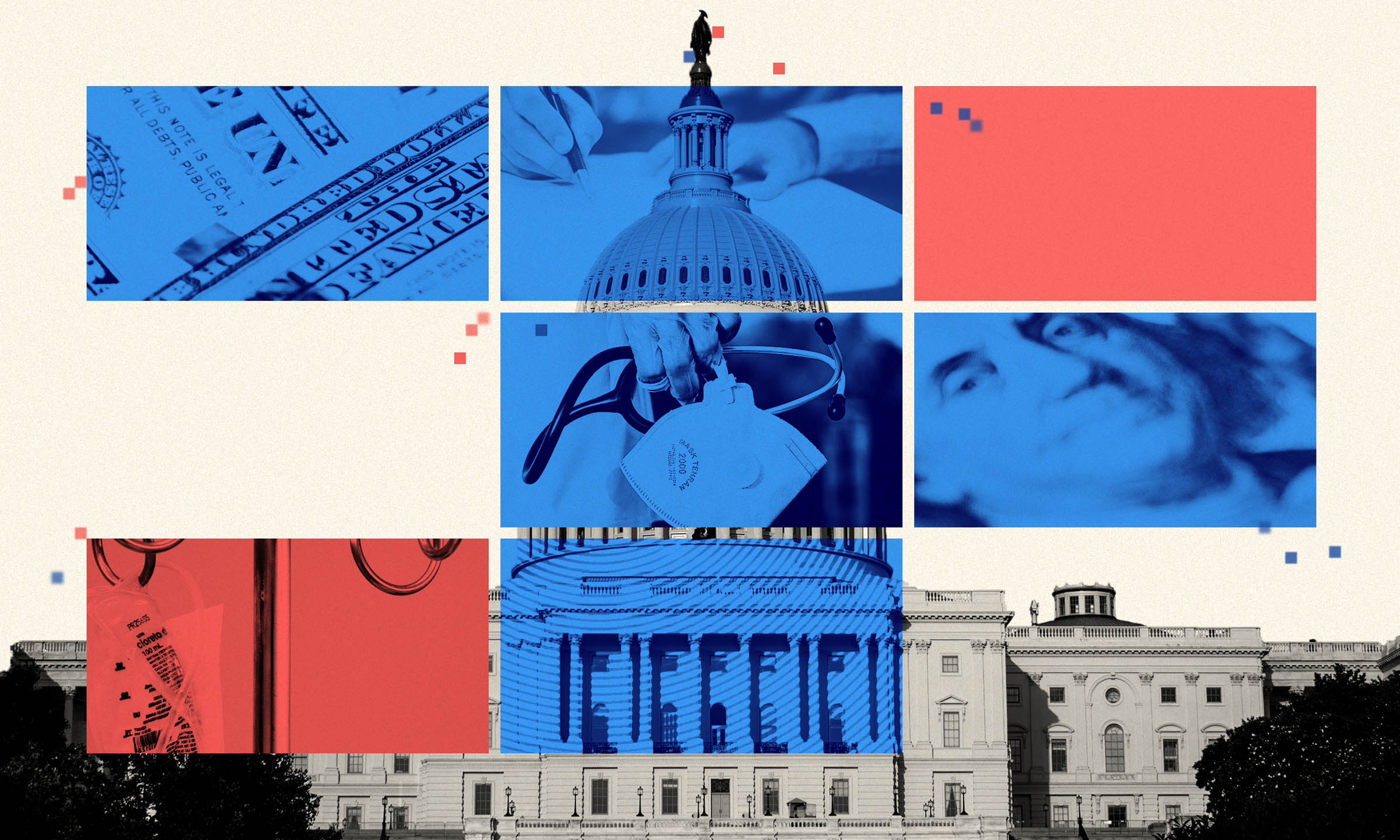3 State and Federal Healthcare Policy Issues to Watch in 2023
Healthcare legislation is a hot topic in 2023. Proposals expected in state legislatures and Congress this year could bring pharmacists reimbursement for their expanding roles, make medication costs more transparent at the point of prescribing and help patients impacted by accumulator programs meet their deductibles.

Healthcare proposals are in state legislative chambers across the country, while federal lawmakers are outlining their prioritiesDrug Pricing Oversight to Get Prime Focus Under New Congress, Bloomberg Law, Jan. 3, 2023—many dealing with similar issues. Among them are containing or cutting medication costs for patients, insurance rules related to accumulator programs and legal authority for pharmacists to provide and be compensated for expanded services.
The implications of proposed changes in statehouses alone could be far-reaching for healthcare, touching patients, payers, pharmacists, providers and pharmaceutical manufacturers.
Medication affordability has been a prime focus for policy change by organizations representing patient needs. According to the latest CoverMyMeds patient survey, which informs the upcoming 2023 Medication Access Report, in the last year, nearly 6 in 10 patients said they learned at the pharmacy counter that their medication cost more than expected. Additionally, one third said they had to stretch out a prescription by taking it on a modified schedule.2022 CoverMyMeds Patient Survey More than a quarter of patients have had to forgo paying bills or buying essential items to afford their medications in the past year, and 17% stopped buying their medications so they could afford to pay their household bills.2022 CoverMyMeds Patient Survey
It’s not just household budgets that juggle significant healthcare costs. About a third of state budgets are dedicated to health.National Conference of State Legislatures, https://www.ncsl.org/health And Medicare, Medicaid, the Children’s Health Insurance Program and Affordable Care Act subsidies consumed 25% of the federal budget in 2022, about $1.4 trillion.Policy Basics: Where Do Our Federal Tax Dollars Go? Center on Budget and Policy Priorities, July 28, 2022
With so much at stake for patients, health systems and state and federal healthcare programs across the country, cutting through the noise can be a challenge. Here are three pieces of state and federal healthcare legislation to watch in 2023.
Granting pharmacists status as providers
The movement to expand pharmacists’ roles beyond counting and dispensing pills has been ongoing for some time. In the last couple of years, the pandemic put pharmacists in the spotlight as the most accessible healthcare provider and demonstrated not only the ability, but the need for pharmacists to have fewer barriers to working with patients.
In 2022, legislation impacting pharmacists’ scope of practice was introduced in 38 states, with 26 of those states enacting changes in law. Many of the laws grant pharmacists and their staff the ability to test for and treat infectious diseases,Provider Status, American Society of Health-System Pharmacists, accessed Jan. 6, 2023 but barriers remain at the federal level. Pharmacists are unable to capture reimbursement for providing these services to federal Medicare patients.Provider Status, American Society of Health-System Pharmacists, accessed Jan. 6, 2023
Legislation introduced in the U.S. House of Representatives in March 2022 would have granted pharmacists provider status for Medicare Part B beneficiaries. The Equitable Community Access to Pharmacist Services Act, H.R. 7213, directed the government health insurance program to pay pharmacists for providing testing, drugs and vaccination for COVID-19, flu, strep throat and respiratory syncytial virus (RSV). The legislation also “generally provides for coverage of pharmacist services during a public health emergency or to address health equity.”H.R.7213 - Equitable Community Access to Pharmacist Services Act, Congress.gov, accessed Jan. 6, 2023
Our thought leaders, your inbox: Sign up for CoverMyMeds’ Insights newsletter.
H.R. 7213 failed to advance with the 117th Congress recessing before voting on the proposal.H.R.7213 - Equitable Community Access to Pharmacist Services Act, Congress.gov, accessed Jan. 6, 2023 The issue of provider status continues to evolve at the federal level. McKesson, along with many stakeholders representing patients and providers, is a member of the Future of Pharmacy Care coalition. This coalition will continue the conversation with policymakers and regulators with a goal of helping patients gain access to the care they need.
On the other side of the issue, the American Academy of Family Physicians, American Academy of Pediatrics and American College of Physicians warned that the proposal could “undermine the physician-led, team-based care models that have been proven to be most effective in improving quality, efficiency and, most important, patient health.”Joint Opposition Letter to Equitable Community Access to Pharmacist Services Act, American Academy of Family Physicians, Dec. 5, 2022
The case for compensating pharmacists to continue these services is compelling. Nearly 9 in 10 Americans live within 5 miles of a pharmacy.Get to Know Your Pharmacist, Centers for Disease Control and Prevention, January 2021 The 2022 CoverMyMeds Medication Access Report found 77% of patients received COVID-19 vaccinations from a pharmacist, and 39% received a vaccination other than COVID-19 from a pharmacist.2022 CoverMyMeds Medication Access Report
More: In Some Medical Deserts, Pharmacists Stand Alone
By conservative estimates, from February 2020 to September 2022, pharmacists’ provision of COVID-19 tests, vaccinations and antivirals in the U.S. avoided more than 1 million deaths, 8 million hospitalizations and $450 billion in healthcare costs.Essential services: Quantifying the contributions of America's pharmacists in COVID-19 clinical interventions, Journal of the American Pharmacists Association, Aug. 18, 2022
Bringing transparency to healthcare benefits and costs
Providers routinely must prescribe medications without any information about how much they will cost the patient or whether they’re covered by the patient’s insurance.
In its annual survey of 1,000 providers, in fall 2022 CoverMyMeds found approximately half of respondents had plan-specific formulary information in their EHR. Just 20% could access pharmacy-specific pricing, a quarter could see the cost on the patient’s plan and 4 in 10 said they could see plan-specific prior authorization requirements within their EHR.2022 CoverMyMeds Provider Survey
Forcing providers into blind decision-making leads to a series of interactions that can end with the patient leaving the pharmacy without their medication. About 40% of patients said insurance barriers were the top reason they experienced a delay in accessing their medications in the past year, and 29% said cost was the top reason. About a quarter of patients said they left the pharmacy without their prescriptions.22022 CoverMyMeds Patient Survey
Forcing providers into blind decision-making leads to a series of interactions that can end with the patient leaving the pharmacy without their medication.
If providers had access to patient plan information at the point of prescribing, in the course of a two-minute conversation, they could tailor the prescription to a medication the patient could afford. They also could begin a prior authorization request, if necessary, rather than having the process kick off later at the pharmacy. Pharmacists wouldn’t have to play phone tag with the provider’s office seeking alternatives or restock the abandoned medication. And patients wouldn’t leave the pharmacy without their meds, facing the possibility that time off work, childcare and transportation may make it difficult to return.
Four states — Colorado,Colorado House Bill 1297 Tennessee,Tennessee House Bill 1398 OhioOhio House Bill 110 and MaineMaine LD 523 — adopted legislation in 2021 requiring payers to grant providers access to plan-specific benefit information within their EHRs. Two more, New YorkNew York Senate Bill S4620C and California,California Assembly Bill 2352 passed in 2022. Virginia is expected to join those six states in 2023.
For patients’ part, sharing necessary data doesn’t seem to be a big concern: 88% of patients responding to CoverMyMeds’ 2022 survey said they were comfortable with different healthcare providers sharing their patient records via EHR systems.2022 CoverMyMeds Patient Survey
Helping patients access medications without interference by accumulator programs
With the employer trend toward high-deductible health plans and the rise in chronic illness — 4 in 10 adults have two or more chronic conditionsChronic Conditions, Centers for Disease Control and Prevention, Dec. 13, 2022 — many more patients are struggling with healthcare costs. The pain is especially acute for low-income families and people who suffer with serious conditions like cancer, which often require complex specialty medications that tend to cost more.
In 2018, out-of-pocket healthcare costs were more than 20% of disposable income for almost half of low-income adults on high-deductible plans.Financial Burden of Employer-Sponsored High-Deductible Health Plans for Low-Income Adults With Chronic Health Conditions, Journal of the American Medication Association, December 2018 The historic levels of inflationConsumer prices up 9.1 percent over the year ended June 2022, largest increase in 40 years, U.S. Bureau of Labor Statistics, July 18, 2022 since then surely have made things more difficult for many families.
With these trendlines, for some patients, pharma copay assistance programs can mean the difference between taking a life-extending medication or not. However, this financial help isn’t always applied to the patient’s deductible or out-of-pocket maximum. These so-called accumulator adjustment programs can cause patients to hit a wall a few months later, having used up the financial assistance that was meant to help them reach their deductible — but hasn’t.Accumulator Adjustment Programs, Arthritis Foundation, accessed Jan. 8 2023
The disruption has implications for treatment adherence and patient health. Patients subject to accumulator programs fill their medications 1.5 times fewer than patients who aren’t.Driving Persistence Among Patients Affected by Copay Accumulators With Patient-Centric Support, Steve Mink and Arran Standring, McKesson, Oct. 18, 2020
Machinations to block accumulator adjustment programs are growing. More than 12 states have enacted legislation nixing them from state health insurance exchanges and some private plans.State legislation against copay accumulators, All Copays Count Coalition, accessed Jan. 8. 2023 At the federal level, a bill with bipartisan support in the 117th Congress failed to advance after being introduced in 2021.H.R.5801 - HELP Copays Act, 2021, Congress.gov
The Help Ensure Lower Patient Copays Act will continue to be pushed by the All Copays Count Coalition, which includes major medical and patient advocacy organizations such as the AIDS Institute, Arthritis Foundation, Cancer Support Community, American Cancer Society and American Medical Association.About Us, All Copays Count Coalition, accessed Jan. 8. 2023
Healthcare policy has the power to change people’s lives. It also carries a significant financial impact to society. National healthcare spending grew 2.7% in 2021 to reach $4.3 trillion, which worked out to $12,914 per person. That was 18.3% of U.S. gross domestic product.U.S. Centers for Medicare & Medicaid Services data, 2022
Stakeholders across the spectrum — patients, providers, pharmacies, pharma, payers and policymakers — have a vested interest in cultivating efficiency and driving down costs in healthcare. Their actions can help make people’s lives better and build a country where everyone can get the medicine they need. Innovation and cooperation are the keys to that future.
CoverMyMeds, part of McKesson, is a healthcare technology company dedicated to helping people get the medicine they need to live healthier lives. For more on how patients, providers and pharmacists are navigating the complex U.S. healthcare system, read the 2022 Medication Access Report.
The latest healthcare insights, floated right to your inbox.





